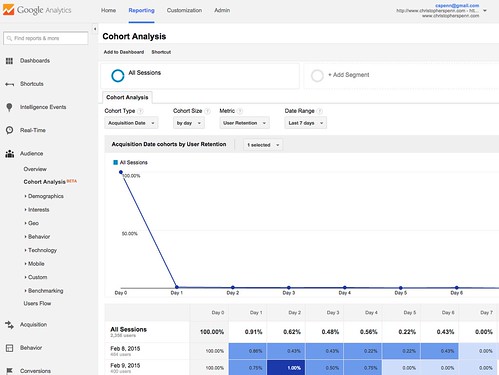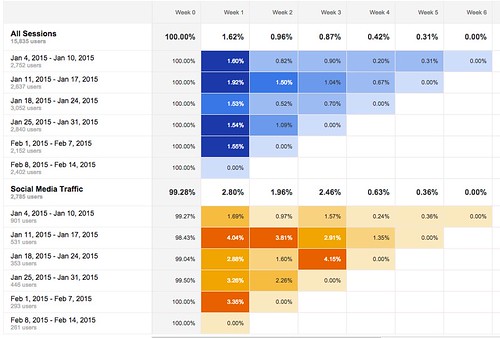Google Analytics recently released its new Cohort Analysis feature. Justin Cutroni did a huge, full writeup on his blog, which is well worth reading. Today, I’d like to dig into a couple of basic use cases for this new report so that you can turn the analysis into something useful.
If you’re unfamiliar with cohort analysis, it’s a method of analyzing different groups of people – cohorts – to see if they behave differently.
Cohort analysis is located under the Audience menu:
Fire it up. What you’ll see to start is something like this:
This is the daily view of people who’ve entered your site over the last 7 days and what percentage of them you’ve retained. We’ll focus on retention in this walkthrough, but you can change the metric to things like conversions, total traffic, and more.
I’ve annotated cohort analysis below so that you can see how it works. If we begin at February 10, we see 100% of the people who visited that day.
At [1] above, we see the number of people who came back on February 11 who originally came in on 2/10, 1.02%. At [2] above, we see the number of people who originally came in on 2/10 who have come back on 2/12, 0.51%.
What does this tell me? It says that my audience rapidly declines day after day very drastically. What might I want to test from that knowledge? If my audience falls off that rapidly, perhaps I need to do paid promotion of my content to ensure that people come back and see it. Perhaps I need to test re-posting to my social channels the content I’ve created recently so as to win back eyeballs at a greater amount. I could test either of these ideas and then come back to this cohort analysis in a few days to see if there’s a significant change.
Out of curiosity, does social media get people to come back? I’ll turn on my social media audience segment and compare everyone vs. just people who visit from social media, and I’ll change the timeframe from daily to weekly:
Wow, look at the difference in the percentage of people who come back from social versus all marketing methods! My social media audience may not be the largest audience I have, but it sure is a loyal one compared to the general population.
Suppose I question whether my email marketing is working or not. I can load an email marketing segment into this:
That’s dynamite. Look at how many people return week after week from email compared to social media. Email by far is my strongest channel so far for retaining my audience.
How about organic search – how does that cohort compare?
Organic search, shown above, performs badly compared to other channels. That’s a piece of analysis that demands I go find some insights. Why does organic search traffic behave differently and less loyally than other channels? The first place I’d look is in Webmaster Tools:
Above, we see that people are finding my site for terms that really aren’t as relevant to most of the content. No wonder organic search’s cohort performs less well on retention – people are finding me for things I don’t write about, and of course there’s no reason for them to come back.
This is the power of cohort analysis, to be able to understand how your different audiences perform over time, as groups. You’ll be able to answer all kinds of questions with the information in cohort analysis.
How often should you blog? Look in your cohort analysis for when people stop coming back, and blog often enough that they don’t lose interest and forget to come back.
How often can you send email? Look in your email segment to find where retention drops off.
What products sell best at what times of year? Look to see if a cohort in your eCommerce analytics behaves significantly differently than others.
Try out cohort analysis and let it inspire you to ask better questions about your audience!
You might also enjoy:
- Almost Timely News, January 14, 2024: The Future of Generative AI is Open
- Almost Timely News, Febuary 18, 2024: From Comment to Content
- You Ask, I Answer: AI Works And Copyright?
- You Ask, I Answer: AI Music Collaborations and Copyright?
- Mind Readings: Hacking Social Media Algorithms
Want to read more like this from Christopher Penn? Get updates here:
 Take my Generative AI for Marketers course! |









Leave a Reply